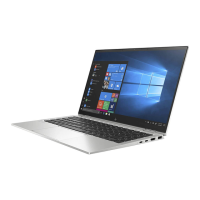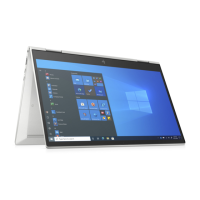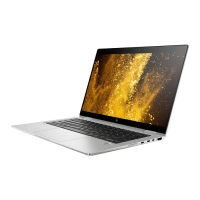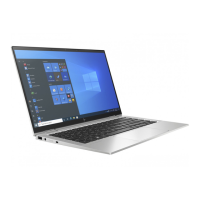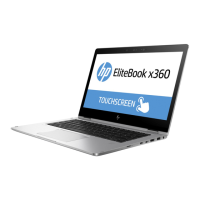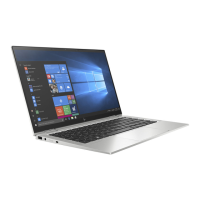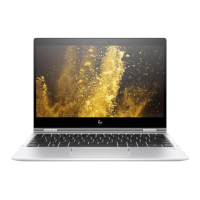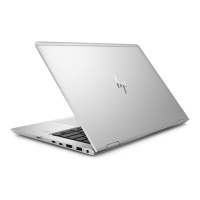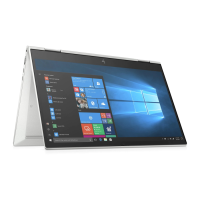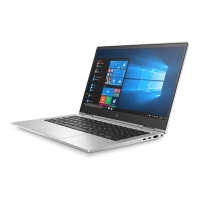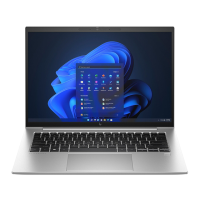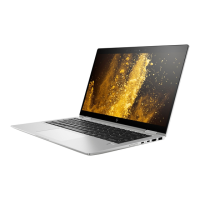
Do you have a question about the HP EliteBook x360 1040 G5 and is the answer not in the manual?
| Storage | Up to 2 TB PCIe NVMe SSD |
|---|---|
| Graphics | Intel UHD Graphics 620 |
| Operating System | Windows 10 Pro |
| Battery | HP Long Life 4-cell, 56.2 Wh Li-ion |
| Processor | 8th Gen Intel Core i5 or i7 |
| Display | 14-inch FHD (1920 x 1080) or UHD (3840 x 2160) touchscreen |
| RAM | Up to 32 GB DDR4 |
| Weight | Starting at 1.35 kg (2.98 lb) |
| Ports | 1 HDMI 1.4; 1 headphone/microphone combo |
| Wireless | Intel 802.11ac Wi-Fi |
| Audio | Bang & Olufsen |
| Webcam | 720p HD camera |
| Security | HP Sure Start, HP Sure Click, Fingerprint sensor |
Lists the official name and model numbers of the HP EliteBook x360 1040 G5.
Details the available Intel Core i5 and i7 processors for the notebook.
Specifies the internal graphics solution used in the notebook.
Describes the different display panel options available for the notebook.
Outlines memory configurations and support for DDR4 system memory.
Lists the types and capacities of supported solid-state drives.
Details audio output and input specifications, including microphone type.
Covers NFC, WLAN, and WWAN module options and specifications.
Specifies battery and AC adapter requirements for the notebook.
Instructions on how to find installed hardware using Device Manager.
Steps to identify installed software applications on the computer.
Identifies and describes components located on the right side of the notebook.
Identifies and describes components located on the left side of the notebook.
Identifies and describes components around the display assembly.
Details the components within the keyboard area, including the touchpad.
Explains the function of various indicator lights on the notebook.
Locates and describes the speakers and fingerprint reader.
Explains the function of special keys on the keyboard, like Fn and Windows keys.
Identifies components located on the bottom of the notebook, such as vents.
Explains the purpose and location of service labels on the computer.
Lists and details major internal computer components and their spare part numbers.
Lists spare part numbers for various accessories and smaller components.
Lists the necessary tools for performing component removal and replacement.
Provides important notes and precautions for disassembly and assembly.
Cautionary advice on handling plastic parts during service procedures.
Guidelines for handling and routing cables and connectors safely.
Precautions for handling storage drives to prevent damage or data loss.
Explains ESD risks and precautions for protecting components.
Grounding guidelines for packaging and transporting computer equipment.
Guidelines for setting up and using a safe workstation for repairs.
Recommendations for grounding equipment and protective materials.
General information and procedures for replacing computer components.
Step-by-step instructions for removing and installing the bottom cover.
Detailed steps for safely removing and replacing the notebook's battery.
Instructions for removing and installing the solid-state drive.
Procedure for removing and replacing the Wireless Wide Area Network module.
Steps to remove and replace the notebook's speaker kit.
Guide for removing and installing the fingerprint reader module cable.
Instructions for removing and replacing the fingerprint reader module.
Steps for removing and installing the NFC module cable.
Procedure for removing and replacing the NFC module.
Guide for removing and installing the TouchPad cable.
Instructions for removing and replacing the notebook's TouchPad.
Detailed steps for removing and installing the system board.
Procedure for removing and replacing the fan and heat sink assembly.
Steps to remove and replace the audio jack board.
Instructions for removing and installing the power button board.
Guide for removing and replacing the notebook's display assembly.
Overview of the BIOS setup utility and its functions.
Steps to access and start the Computer Setup utility.
How to use USB input devices to enter BIOS setup.
Methods for navigating and making selections within the BIOS menus.
Instructions to reset BIOS settings to their factory defaults.
Information and steps for updating the computer's BIOS.
Guide on how to find and download BIOS updates from the HP website.
How to dynamically select a boot device using the F9 menu.
Configuration of Trusted Platform Module (TPM) settings in BIOS.
Explanation of HP Sure Start technology for BIOS protection.
Steps to download diagnostic tools to a USB drive.
Overview of remote diagnostic capabilities and settings.
How to configure advanced settings for remote hardware diagnostics.
Instructions for backing up data and creating restore points using Windows.
Guide to creating recovery media using HP's specialized tool.
Information on restoring the system to its original state or refreshing it.
Steps to use HP Recovery media for system restoration.
How to modify the boot sequence for recovery media.
Detailed technical specifications for the notebook's hardware.
General requirements for power cord sets applicable globally.
Specific power cord requirements based on country or region.
Explains the purpose and characteristics of nonvolatile memory types.
